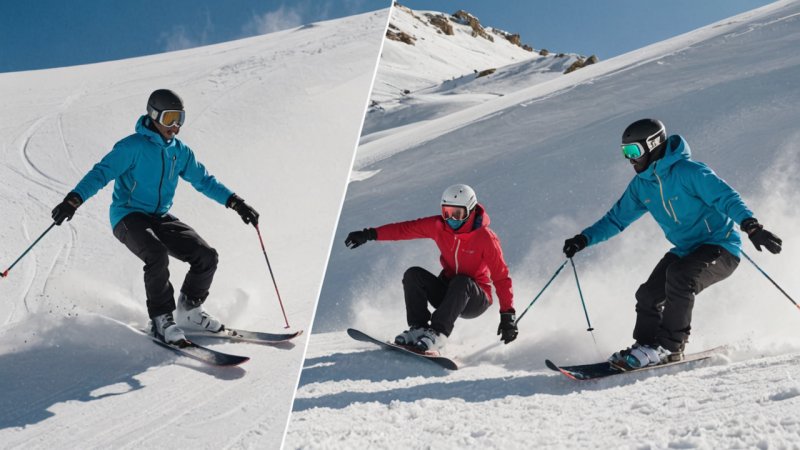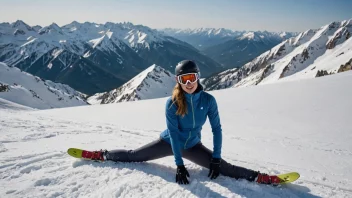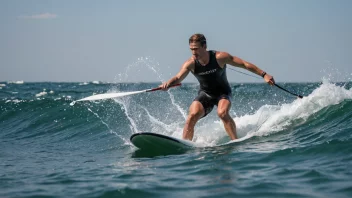Winter sports offer a unique blend of excitement, skill, and diversity, with skiing and snowboarding being two of the most popular disciplines. Each sport requires distinct techniques, physical conditioning, and mental preparation. In this article, we will explore the key differences between training for skiing and snowboarding, examining the specific demands each sport places on the athlete. By understanding these differences, athletes can better adapt their training routines to enhance performance while prioritizing safety.
Understanding the Fundamentals
Both skiing and snowboarding are thrilling winter sports that take place on snow-covered slopes, but they differ significantly in terms of equipment, stance, and movement. Skiers use two separate skis, allowing for independent leg movement, while snowboarders ride on a single board, requiring a more unified body motion.
Equipment Differences
The equipment plays a crucial role in how each sport is approached. Skiers typically wear ski boots that allow for greater mobility at the ankles, while snowboarders use stiffer boots that provide better control over the board. The differences in equipment lead to varying training needs.
- Ski Boots vs. Snowboard Boots: Ski boots are generally lighter and allow for greater ankle flexibility, which is essential for maneuvering on varied terrain. Snowboard boots, being stiffer, provide more support for the ankles but can limit movement.
- Poles vs. No Poles: Skiers often use poles to help with balance and timing, which adds another element to their training. Snowboarders must focus on using their entire body for balance.
Stance and Movement
The stance is another fundamental difference. Skiers face forward on their skis, whereas snowboarders ride sideways on their board. This difference affects how athletes train their muscles and stability.
- Forward Stance (Skiing): Skiers need to develop strength in the quadriceps, hamstrings, and calves, focusing on movements that enhance forward motion and balance.
- Sideways Stance (Snowboarding): Snowboarders require strong core muscles and flexibility, as they need to shift their weight from edge to edge while maintaining a low center of gravity.
Physical Conditioning
Both skiing and snowboarding demand high levels of fitness, but the specific conditioning required can differ greatly. Here, we will analyze the physical conditioning needed for each sport.
Strength Training
Strength training is essential for both skiers and snowboarders, but the focus areas may vary:
- Skiing: Skiers should concentrate on leg strength, particularly in the quads and glutes, as well as upper body strength to assist in pole usage and balance.
- Snowboarding: Snowboarders should focus on core stability and lower body strength, particularly in the hips and thighs, to facilitate quick movements and balance.
Endurance and Agility
Endurance plays a critical role in winter sports:
- Skiing: Skiing often requires prolonged periods of activity, necessitating good aerobic conditioning. Skiers can benefit from cardio workouts like running or cycling.
- Snowboarding: Snowboarding sessions tend to be shorter but require explosive bursts of energy, making agility training, like plyometrics, crucial.
Technique and Skill Development
Technique is vital in both skiing and snowboarding, but the skill sets differ considerably. Both sports require a foundation of basic skills that evolve into more advanced techniques.
Learning Curve
The learning curve for each sport can vary:
- Skiing: Many beginners find skiing easier to learn initially due to the stability provided by two skis. The learning process often focuses on balance and turning techniques.
- Snowboarding: Snowboarding can be more challenging at first as athletes must learn to balance on a single board. The initial learning phase can involve more falls, but many find progression faster once the basics are mastered.
Advanced Techniques
As athletes progress, they will need to develop more advanced techniques:
- Skiing: Advanced skiers work on carving turns, mogul skiing, and navigating different types of terrain. They also focus on maintaining speed and control.
- Snowboarding: Advanced snowboarders focus on tricks, jumps, and navigating terrain parks. They often practice rotational movements and switch riding.
Safety Considerations
Safety is paramount in both skiing and snowboarding, and understanding the risks associated with each sport can help athletes stay safe while enjoying their time on the slopes.
Common Injuries
While both sports carry risks, the types of injuries often differ:
- Skiing: Common injuries include knee ligament injuries, ankle sprains, and shoulder dislocations. Skiers should focus on strengthening their legs and improving flexibility to mitigate these risks.
- Snowboarding: Snowboarders frequently experience wrist injuries and shoulder dislocations, primarily due to falls. Wearing wrist guards and practicing proper falling techniques can reduce injury risk.
Protective Gear
Having the right protective gear is essential:
- Skiing: Skiers should wear helmets, goggles, and padded shorts or vests for added protection.
- Snowboarding: Snowboarders are advised to wear helmets, wrist guards, and padded shorts to protect against falls and collisions.
Conclusion
In conclusion, both skiing and snowboarding present unique challenges and training requirements. While skiing emphasizes leg strength and endurance, snowboarding focuses on core stability and agility. Understanding these differences allows athletes to adapt their training programs effectively, ensuring they improve performance while minimizing the risk of injury. Ultimately, whether you choose to ski or snowboard, prioritizing safety and proper training will lead to a more enjoyable winter sports experience.






